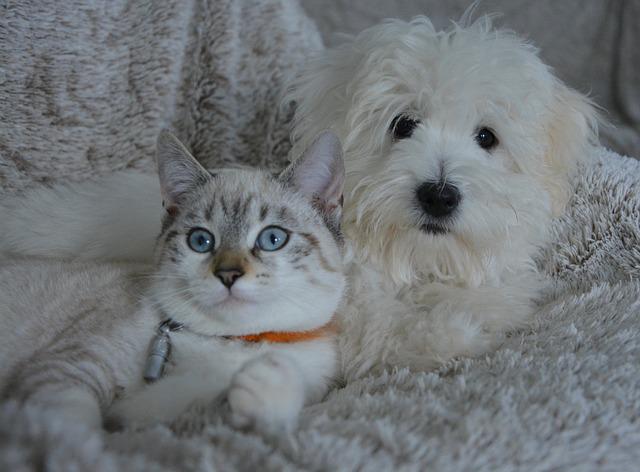Most animal guardians believe that most acute and chronic illnesses experienced by their dogs and cats can be treated only by conventional veterinary medicine [allopathy] since the conventional view has been promoted as gospel and has rarely been challenged.
While standard veterinary intervention may excel in emergency situations and in times when the animal is weak and vulnerable, it is surpassed by more viable approaches which acknowledge and respect the sanctity and intelligence of the organism.
Homeopathy is one excellent option for the treatment of acute and chronic conditions in animals. Its gentle remedies are perfectly suited to the sensitivity of the animal body and for rebalance without suppressing, or creating, iatrogenic [drug-induced] diseases.
Conventional veterinary medicine is predicated on the belief that 1] the symptom is the illness; 2] the body can be divided into parts and that the parts are not interrelated; 3] illness can be corrected by addressing the part without addressing the whole; 4] the body does not know how to regain health and the symptoms it manifests are troublesome and have no meaning; and, 5] crude, poisonous substances that suppress the body’s natural healing intelligence can effect a cure.
Homeopathy dispels these beliefs.
Homeopathy was founded over 250 years ago and is based on the understanding that the body is an integral whole and that an organism is comprised of electromagnetic energy fields from which the physiological body is created. These energy fields are the templates, or blueprints, from which the organism manifests. Dr Samuel Hahnemann, MD, homeopathy’s founder, described these fields as the ‘dynamis,’ or the spiritual ‘vital force,’ the invisible energy that animates the material body. He understood that it is imbalance that originates on the energetic plane that is the root cause of acute and chronic disease and that cure can only be achieved by addressing these energy imbalances.
Bringing Balance
Homeopathy addresses acute and chronic disease by stimulating the imbalanced electromagnetic fields to rebalance by using meticulously prepared homeopathic remedies which are non-toxic, highly-diluted, energised substances. The remedies are not the crude poisons of allopathy, but are information carriers which function much like DNA to gently stimulate the body to complete what it has already begun to do.
Symptoms from the homeopathic standpoint are not the illness, but merely an indication of a disruption in the organism’s energy fields. Further, symptoms are understood as being the organism’s attempt to correct these imbalances. Accordingly, in order to effect a cure, the total symptom-picture which the organism exhibits on all levels — spiritual/mental, psychic/emotional and physical — must be paid close attention to. The ailing animal must be understood as a whole, not a machine, capable of being reduced to its parts, since addressing only the part further imbalances the organism.
Homeopathy matches the symptom-picture of the animal to the symptom-picture of a homeopathic remedy that has been determined through stringently controlled ‘provings’ on healthy human subjects. This gently corrects the imbalances that lie at the root of disease.
Useful First-Aid
Homeopathy is invaluable in first-aid and injury situations and in acute and chronic diseases. It is also an effective complement to necessary conventional veterinary treatment where it supports and accelerates the healing process, counteracts the effects of crude drugs and rebalances the animal’s energy fields.
Injuries, wounds, bites, bruises, strains, sprains, etc., can be safely treated by a guardian who has received basic training in the science, as can minor acute conditions, such as certain short-term, self-limited behavioural problems, digestive disturbances, bladder and skin conditions, etc. Chronic ailments such as arthritis, compromised kidneys and other serious acute and chronic conditions respond well to homeopathy, but require the intervention of a professional homeopath.
Spring is just around the corner and my four-legged companions are already enthusiastically sniffing the new air. Everything around them will soon be catching their attention as the winter chill dissipates and the world again becomes a vast playground to discover and explore. Their curiosity can, however, lead them into a good deal of trouble for with the sunshine and warm breezes come a variety of insects that will do anything to defend themselves against our eager companions.
Insect bites can not only be painful to small animals; they can also be dangerous. So, here are some guidelines designed to help guardians deal with the wounds inflicted by bites and stings.
5 Useful Homeopathic Remedies
There are five important remedies for bites and stings that should be a part of your emergency homeopathic first-aid kit. They are Apis mellifica; Carbolic acid; Ledum palustre; Hypericum perforatum; and, Urtica urens.
Apis and Carbolic acid are important remedies to remember in cases where an animal goes into an anaphylactic state as a result of a bite, or sting. The animal is having an allergic reaction. The face and tongue may be swollen; it may have difficulty breathing and may be cold to the touch. Take your animal to the veterinarian immediately and on the way give the best indicated of the following:
Apis 30C for bites from bee stings and yellow jackets, etc., where there is puffy, water-like [oedematous] swelling and the animal is worse from touch and heat. Administer the pellets on the tongue every 10-15 minutes.
Carbolic acid 30C is specific for anaphylaxis to bee stings. So, if you have identified the insect, give the pellets every 10-15 minutes.
Ledum and Hypericum are important remedies to consider in cases of puncture-like bites, stings and poisonous spider bites.
Administer the best indicated of the following:
Ledum 30C when the wound ‘feels’ cold and the area appears bluish. All symptoms are worse from heat and scratching. Like Apis, Ledum is effective for wasps and yellow jackets.
Hypericum 30C is useful when the wound is on, or near, any part of the spine, or tips of fingers, or toes, and there is excessive pain and severe itching.
As a fifth option, consider Urtica in bites and stings that also have itchy blotches and swelling. There may be extreme itching and clear, sticky discharge.

